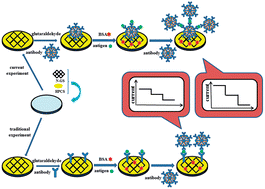Ultrasensitive dual amplification sandwich immunosensor for breast cancer susceptibility gene based on sheet materials†
Abstract
A new electrochemical dual amplification sandwich immunosensor (DASI) was designed for ultrasensitive and accurate detection of the breast cancer susceptibility gene based on the combination of N-doped graphene, hydroxypropyl chitosan and Co3O4 mesoporous nanosheets. N-doped graphene has better electroconductibility than traditional graphene. It is an ideal electrochemical material with a large specific surface area and low resistance. Hydroxypropyl chitosan replaces the pure chitosan in immobilization of the sensor to achieve the sensitivity increase. Co3O4 mesoporous nanosheets can enhance the effective area of the immunoreaction. This kind of dual amplification sandwich immunosensor was first used for the detection of the breast cancer susceptibility gene. It has a wide linear response range of 0.001–35 ng mL−1 and a minimum detection limit of 0.33 pg mL−1. It was demonstrated that the stability, selectivity and reproducibility of the sensor were acceptable. The fabricated immunosensor shows great potential applications in early disease diagnosis.


 Please wait while we load your content...
Please wait while we load your content...